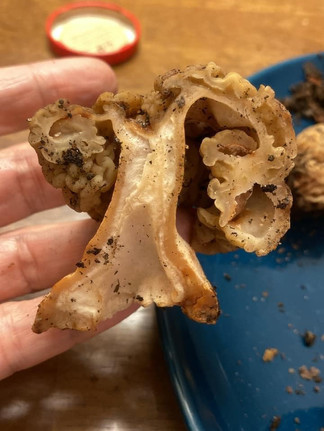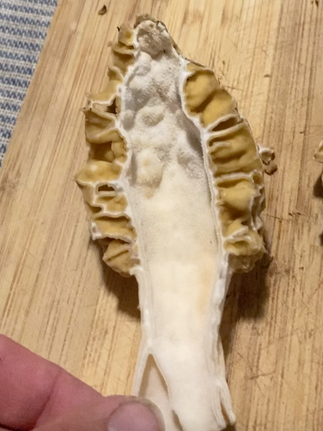The title of this article is a nod to a Facebook group of the same name, where folks are making an effort to vindicate false morels, many of which have gotten a bad rap over the years. There are a vast number of so-called "false morels" coming from a variety of fungal groups. The majority of them, like morels, are of the the division of fungi known as ascomycota, rather than basidiomycota which comprises the majority of "typical" mushrooms. Ascomycetes actively "shoot" their spores from sacs called asci, whereas basidiomycetes passively drop their spores from structures called basidia. True morels are of the morchella genus in the morchellaceae family, whereas there are several other genera of ascomycetes that resemble morels. These are the gyromitra and verpa genera. Many people suggest that false morels are poisonous and even deadly and in some cases this is true. It is also accurate that some false morels can be safely eaten and are even considered a choice edible. The focus of this article is to learn about the different genera and species of false morels as well as a note on edibility of these towards the end.

Identification
Gyromitra Genus (Helvellaceae family)
I would say that gyromitra is probably the most notorious of the morel look-alikes, so I wanted to cover this one first. Its notoriety stems in large part from controversy as to whether or not they are edible (and delicious, as its advocates will tell you) or deadly poisonous, as others will warn. They may have the capacity to be both, which will be discussed in the "Edibility" section below. Spoiler alert, the most poisonous one that needs to be treated with the most caution is the first one we'll discuss: gyromitra esculenta.

Gyromitra esculenta is a false morel that grows in spring near conifers and occasionally near hardwoods. It has a creamy or tan stem and a brainlike cap. Its cap is typically a reddish brown to dark brown or even purplish. Unlike a morel, which tends to be relatively symmetrical with ridges and pits on the cap, g. esculenta is typically not symmetrical and appears more squished and wrinkled rather than ridged and pitted. It almost looks more like a floret of cauliflower, rather than a morel. If sliced in half, the hollow portion of the stem of g. esculenta stops once it reaches the cap and then there will be segmented hollow portions throughout the cap and stem. A true morel's stem on the other hand is hollow starting at the base of the stem and running vertically to the top of the cap without interruption, and the cap is just colored ridgelike structures growing out from the stem.
The snowbank morel, also known as gyromitra gigas (or g. montana in western N. America and g. korfii in eastern N. America), is different from g. esculenta due to its frequently enlarged stem and typically larger size (although in some cases g. esculenta can grow to be similar proportions, but still having a narrow stem). In western N. America, g. montana grows near conifers (as does g. esculenta) and it is the false morel most frequently confused with g. esculenta, according to reports to the North American Mycological Society. It typically has a light brown to reddish brown cap and apparently in the rockies and in the coastal ranges of Pacific, g. esculenta is frequently found with enlarged caps and reddish brown coloration. Still, the stem of a g. montana should distinguish itself from a g. esculenta, as the g. montana stem will be a similar size to the cap, whereas the esculenta stem will significantly taper and be much small in width than the cap. In eastern N. America and the midwest, g. korfii grows under both hardwoods and conifers. G. korfii often has less folds or wrinkles than its western brother, the cap almost appearing like a tablecloth draped over the thick stem. It is also more likely to be a pale brown or tan color.
In eastern parts of the N. America there is also the gyromitra caroliniana and gyromitra brunnea. These two typically have reddish brown caps with a white or cream colored stem. The stems can grow quite large on both of these species. The biggest identifier between the two is that the g. brunnea has two or more lobes that grow together with partially fused seams. These lobes can be wrinkled or folded but also may have relatively smooth areas as well. G. caroliniana has a much more morel-like cap, with dramatic ridges and valleys evenly distributed around a fairly spherical or cylindrical cap.
Photos above show (numbered 1-6 clockwise from top left): 1 and 2. Cross sectional cuts of G. Brunnea showing chambered stem and cap. 3 and 6. Cross sectional cuts of morchella semilibera (half free morel) shows how the stem is attached to the cap part way down and runs hollow up the center. 4. Cross sectional cut of true morchella esculenta shows how the stem is hollow with the cap running down the stem, attached all the way to the cap margin. 5. Cross sectional cut of verpa bohemica shows cottony fuzz in stem and how the cap is fused just at the top of the stem, almost as if draped over the top
A final gyromitra species that is worth mentioning is the gyromitra infula or gyromitra ambigua. It is a smaller mushroom with a well defined stem and saddle shaped cap that, in my opinion, would be more easily mistaken for an elfin saddle (helvella spp.) than a true morel. G. Infula has a tan to reddish brown saddle and g. ambigua has a purplish saddle. What's easy about g. infula is that it grows in late summer and fall, rather than spring, so it's not likely to be confused with a true morel.
Verpa Genus (Morchellaceae family)
The verpa genus is distinct from gyromitra in that they are within the morchellaceae family, just not in the morchella genus. There are only two species in this genus, verpa

conica and verpa bohemica. They both are easily differentiated from true morels by the fact that the cap and stem of a verpa are fused together only just at the tip of the mushroom, whereas true morels are fused along the length of the cap but are free just above the margin of the cap. Verpas typically fruit a week or two sooner than morels, and unlike morels they often have a cottony filling throughout the stem. Verpa conica and verpa bohemica, furthermore, can be distinguished by the fact that verpa bohemica has a wrinkled cap whereas the cap of verpa conica is smooth.
Edibility
For starters, as with all wild mushrooms or plants, never eat anything unless you have verified the identity of the thing you are about to eat with multiple sources and are 100% confident you have the correct identification. With that out of the way, let's break down the species discussed above, in terms of edibility.
The easiest one to tackle first is the verpa genus. As noted in the text above, these are closely related to true morels (morchella genus). They are also commonly eaten (must still be cooked first, just as true morel must be cooked). It is worth noting that verpa bohemica does not agree with all people and thus, I would recommend exercising some restraint when eating this mushroom, starting off with only small amounts until establishing your personal level of tolerance.
Next, let's discuss the more convoluted topic of gyromitras, which I will divide into three main categories. The first one to be familiar with is gyromitra esculenta. It is very important to recognize that the warnings with respect to gyromitra false morels stem largely from this mushroom as it is the most toxic and sometimes even deadly poisonous of all the false morels. Gyromitra esculenta contains a toxin called "gyromitrin". Once consumed, this toxin converts to monomethylhydrazine (MMH) in the body, which is poisonous and in large enough quantity can cause serious complications including liver failure and death (though rare). With that said, MMH is also very volatile and so when g. esculenta is cooked, the compound will vaporize and can be rendered safe. To properly prepare g. esculenta to consume, it must be boiled multiple times (in an open air setting as the MMH vapors could still poison a person), using fresh water with each boil. It must then be sauteed or cooked under medium high heat prior to consuming. To me, it seems like it's an easier and safer bet to simply avoid consuming gyromitra esculenta. Another toxic gyromitra is the g. leucoxanatha, though I am only briefly noting this, because it is a cup fungi and looks nothing like a false morel or a true morel but is simply in the same family.
The next group of gyromitras are the g. americanigigas (both the g. montana and the g. korfii), the g. caroliniana and the g. brunnea. These are among the slew of false morels that have fond nicknames such as snowbank morel, beefsteak fungus, and big reds or red morels, among others. These are all regularly consumed in Europe and throughout the United States and only require a simple panfry, just as a true morel must also be cooked thoroughly. There has been no evidence of confirmed poisonings by these species as well as no evidence that they contain any of the gyromitrin toxin that makes g. esculenta so dangerous. Not only that, but many consider these mushrooms to be absolutely delicious--among their favorite of all mushrooms.
The final group of gyromitra false morels are sometimes referred to as hooded or saddle morels. These consist of g. ambigua and g. infula. These mushrooms are difficult to mistake with a morel because of the fact that they fruit in the fall, rather than spring which is typically considered the peak of morel season. Both of these mushrooms feature a well defined stipe and distinct cap that is typically two lobes but sometimes three that are pinched in the middle. It resembles a fortune cookie atop a mushroom stem. These fungi have long been considered to have gyromitrin present similar to g. esculenta. Recent research shows that gyromitrin, shown below, suggest otherwise. Personally, I would avoid this mushroom until more is known.

Here is a helpful chart showing many of the different species of the gyromitra genus and the corresponding gyromitrin levels detected within each species. It is worth noting that as with all things found in nature, there is variability and I would not use this table or this article as the end all be all of whether or not a species is poisonous. I would pair that with knowledge gained from other experienced foragers, scientific literature on foraging, and field guide books to make an informed decision on whether or not something is safe to eat. Even then, I would recommend exercising caution if it is your first time eating a particular species of mushroom, as food allergies extend beyond the world of dairy and gluten into the realm of mushrooms as well!
References:
Beug, Michael W (2014): False Morels, Fungi, website: https://www.fungimag.com/spring-2014-articles-02/V7I1%20LR%20FalseMorels28-31pdf.pdf
Alden C. Dirks, Osama G. Mohamed, Pamela J. Schultz, Andrew N. Miller, Ashootosh Tripathi & Timothy Y. James (2022): Not all bad: Gyromitrin has a limited distribution in the false morels as determined by a new ultra high-performance liquid chromatography method, Mycologia, DOI: 10.1080/00275514.2022.2146473
Arora, David (1986). Mushrooms Demystified. New York: Ten Speed Press.
Kuo, Michael (2014). Mushrooms of the Midwest. Champagne-Urbana: The University of Illinois Press.
Kuo, Michael (2005). Morels. Ann Arbor: The University of Michigan Press.
Lincoff, Gary (1981). National Audubon Society Field Guide to North American Mushrooms. New York: Chanticleer Press, Inc.













Comments